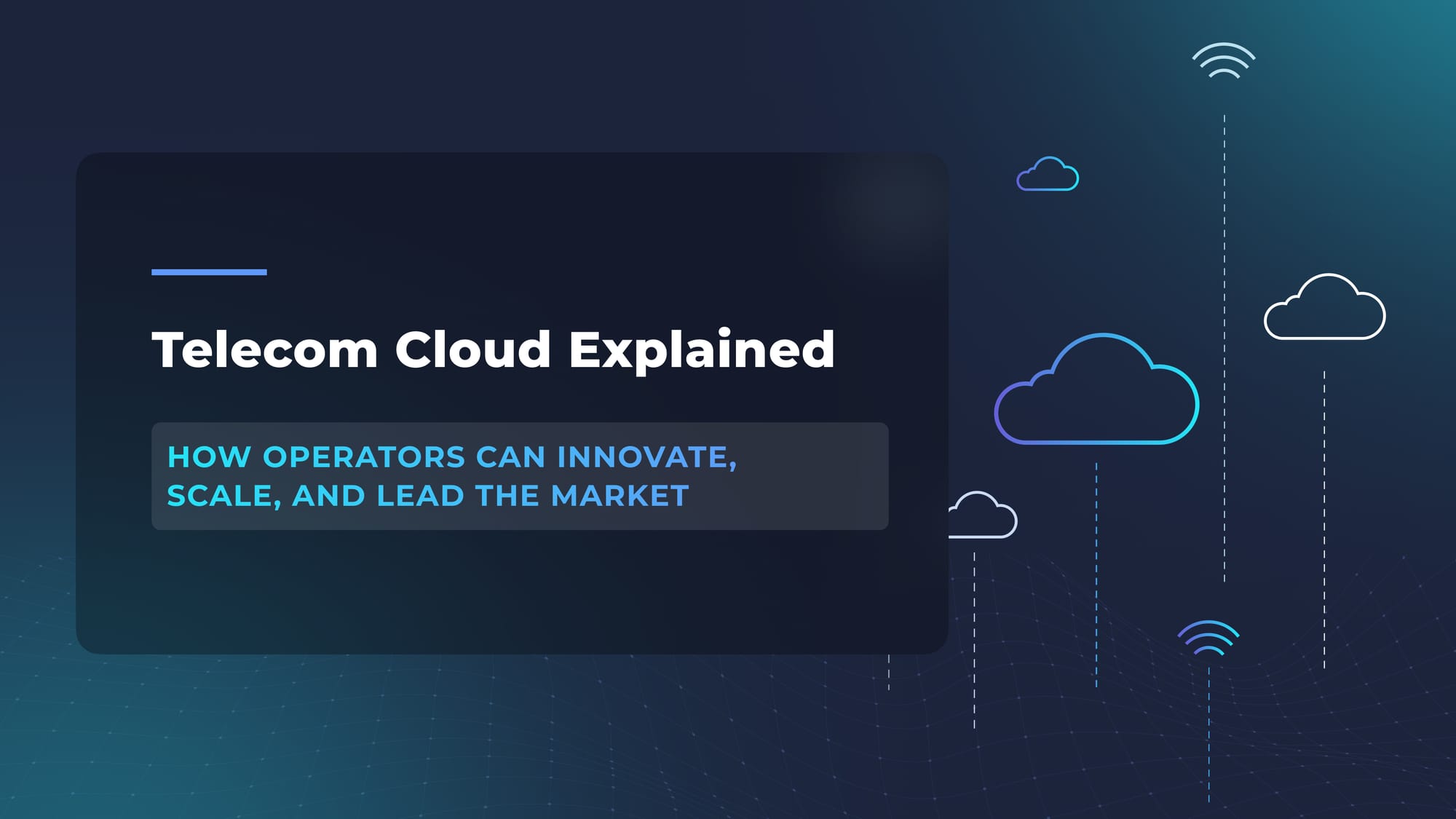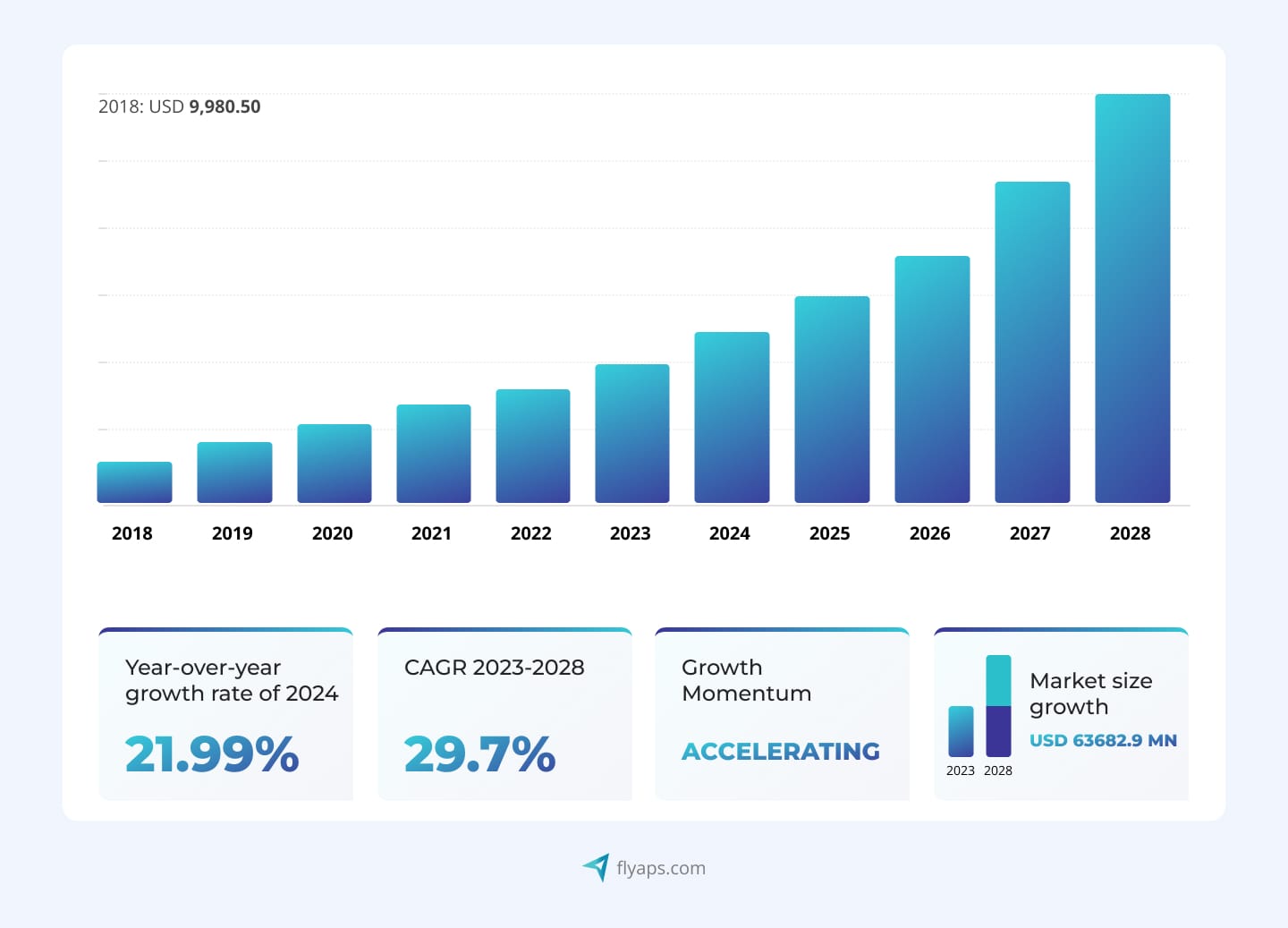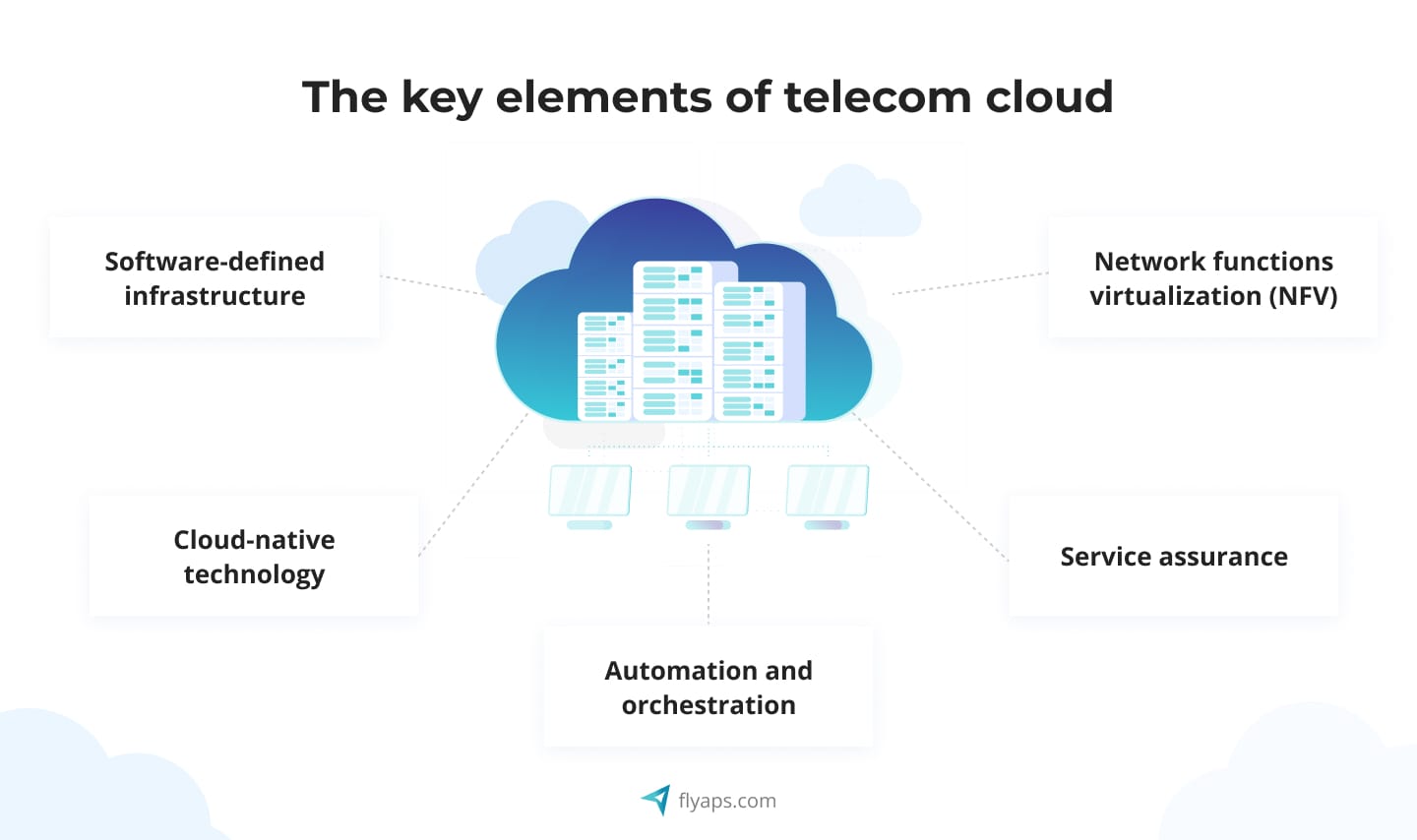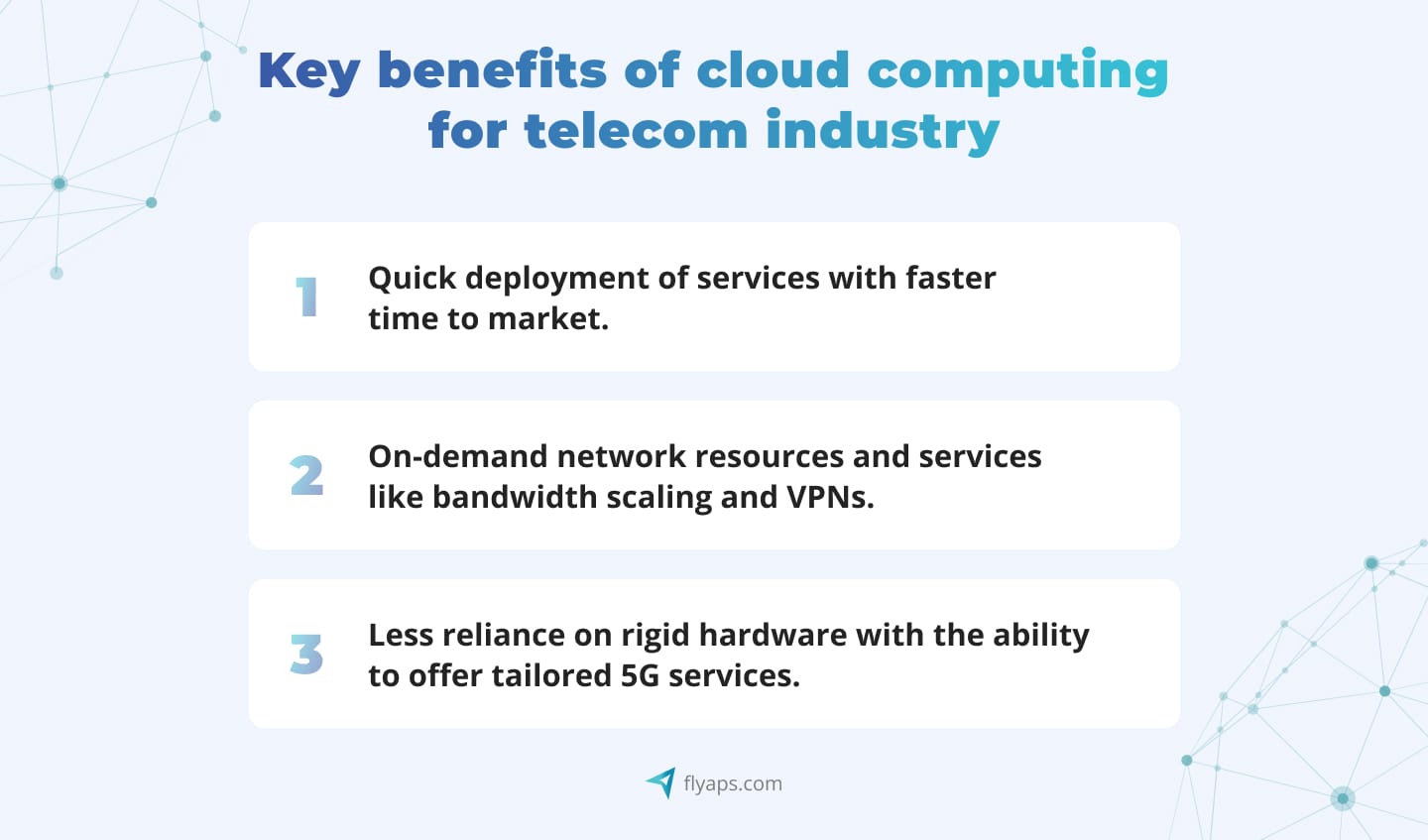Telecom Cloud Explained: How Operators Can Innovate, Scale, and Lead the Market

The telecom cloud market size is forecast to increase by $63.68 billion, at a CAGR of 29.7% between 2023 and 2028. Many companies are moving away from traditional virtual network functions (VNFs) toward cloud-native solutions. What has caused such a massive transition?

The answer is 5G and the immense growth potential it offers to the telecom businesses. However, legacy VNFs simply can’t keep up with 5G demands. Performance bottlenecks, scalability challenges, and high upfront costs are making it clear that telecoms need a more flexible, cost-effective solution.
This is where telecom cloud services come in. Unlike older VNFs, cloud-native solutions are built using containers and microservices that can offer the flexibility, scalability, and efficiency needed for modern technologies. But the transition to the cloud isn’t easy. As telecoms must balance running legacy VNFs while integrating new cloud-native network functions (CNFs), telecom cloud services provide the required foundation for this transformation, enabling operators to meet 5G requirements while optimizing their networks for the future. And if you're wondering what it takes to develop these types of AI-powered cloud systems in 2025, we've broken it down in our article.
At Flyaps, we’ve been working in the telecom industry for more than 10 years now, building and overhauling custom solutions for global providers. In this article, we’ll explore what telco cloud is, and how it can help operators stay competitive. Let’s start with the definition of telecom cloud.
What is telco cloud?
Telco cloud refers to a cloud-based infrastructure specifically designed for telecom networks. Unlike traditional telecom setups, where operators had to rely on fixed hardware, the telco cloud allows them to manage their networks more efficiently using virtualized, software-based solutions. This flexibility helps telecom companies quickly add new services, scale up or down to meet network demand and manage both central and remote resources more easily.

In the early days, most telco clouds were built in private environments. This gave telecoms full control over their networks, but it came with a hefty price tag. But with the rise of containerized services, things have changed. Today, less critical network functions can be offloaded to public clouds, which reduces costs and allows telecoms to adapt more quickly to changing market demands. At the same time, some high-performance functions like voice and video communications or core network functions still need to stay in private clouds for optimal performance.
This leads to one of the key challenges for telecom companies: finding the right balance between keeping high-performance network functions in private clouds and moving less critical ones to public clouds to save costs. The solution lies in hybrid and multi-cloud strategies, where operators use a mix of private and public cloud environments to optimize both performance and costs.
But let’s not focus on challenges only, let’s dive into the key benefits of adopting telco cloud services.
From cloud migration to telecom-specific AI solutions, we have delivered over 20 projects that are used by hundreds of MNOs and telecom companies worldwide. Check our capabilities and let’s discuss your next solution.
See our servicesThe main benefits of cloud services for telecom
Telco cloud offers a range of practical benefits that help telecom operators adapt to today’s fast-paced market, roll out new services quickly, and improve overall efficiency. Let’s explore some of its key advantages.
Key benefits of cloud computing in the telecom industry Quick deployment of services with faster time to market. On-demand network resources and services like bandwidth scaling and VPNs. Less reliance on rigid hardware with the ability to offer tailored 5G services.

Faster time to market
One of the biggest strengths of cloud-based telecoms is its ability to speed up the delivery of new services. Telecoms can use virtualized infrastructure instead of relying on physical hardware to build and launch scalable, software-based services quickly. This not only saves time but also allows telecoms to introduce unique offerings that competitors can’t easily copy. For example, operators can create custom business packages, bundling communication tools like voice, video, and messaging in a matter of days, rather than months. This rapid deployment ensures telecoms can keep up with market trends and better meet customer demands.
Foundation for NaaS (Network as a Service)
Telecom cloud is essential for enabling Network as a Service (NaaS), a model where operators offer network computing resources on demand. With NaaS, customers can scale their network needs based on real-time demand, which is especially important for businesses with fluctuating data usage. For telecoms, this gives an opportunity to offer services like bandwidth on demand, dynamic routing, and virtual private networks (VPNs) as flexible, subscription-based products. Simply put, telco cloud allows telecoms to deliver these services more efficiently, ensuring quick scalability and customization, which can lead to new revenue opportunities, especially with 5G and IoT applications.

Read more about IoT in telecom in our dedicated article
Capitalizing IoT Roaming for Data and Financial Clearing Houses: the Role of Cloud and AI
More efficient 5G monetization
At the core of telecom cloud is its potential to help telecoms monetize their 5G investments. Telco cloud reduces the reliance on expensive, rigid hardware and enables operators to scale their networks as needed. This flexibility lets telecom companies offer premium 5G services such as low-latency connections for gaming or ultra-reliable communications for industries like healthcare and manufacturing. By combining cloud-native infrastructure with hybrid cloud strategies, telecoms can offer targeted, high-value services that meet specific 5G use cases, turning their 5G networks into profitable ventures.
To see how these benefits manifest themselves in real life, let’s explore 3 use cases of transitioning to telecom cloud.
3 real-world use cases of cloud telecom
Here are some examples of how telco cloud is being used by major telecom operators.
Case #1: Telefonica O2 and unified communications on the cloud
Telefonica O2 launched O2 Unified Communications, two cloud-based unified communications solutions tailored to meet diverse business needs:
- O2 Voice for Microsoft Teams integrates traditional telephony with Microsoft Teams, allowing businesses to make and receive external calls directly through the Teams platform. This approach helps companies streamline communication by combining voice services with the collaboration tool they already use. Businesses can choose exactly what they need, whether it's call recording or enhanced voice features, without paying for unnecessary services.
- O2 Just Call Me offers a hassle-free conference call solution that turns any phone into a conference line without requiring pins or codes. This service is designed for businesses that need a flexible, easy-to-use communication tool for conferencing without added complexity.
Both services are built on telco cloud infrastructure, allowing Telefonica O2 to deliver customized solutions quickly while scaling services based on specific client needs. The cloud-based approach ensures cost-effectiveness, as clients only pay for the services they use, offering a more personalized and flexible way to manage communications.
Use case #2: Vodafone and cloud-native 5G mobile core
In 2021, Vodafone Germany, in partnership with Ericsson, became the first operator in Europe to launch a cloud-native 5G standalone core network. By shifting to the telecom cloud, Vodafone replaced older LTE-based 5G systems with more advanced cloud infrastructure. This allowed them to offer network slicing and ultra-low latency, which are key for industries like online gaming, virtual reality, and industrial automation.
Using the telecom cloud, Vodafone could quickly expand its 5G services across multiple regions without needing expensive hardware upgrades. Additionally, the cloud-based system allowed Vodafone to roll out new 5G services, like enhanced mobile broadband, much faster than before. This transition to the telco cloud helped Vodafone stay ahead in the market by offering faster, more flexible services while reducing operational costs and complexity.
Use case #3: Orange and 5G edge computing
Orange teamed up with Google Cloud to bring edge computing to their network, enhancing their 5G capabilities. The goal was to provide faster, more secure services for both consumers and businesses by processing data closer to where it’s being used, reducing latency to below 10 milliseconds.
Using Google Cloud’s Anthos platform, Orange built an Edge Computing Lab that helps businesses quickly develop and test new solutions. For example, companies can now deploy cutting-edge applications like real-time analytics, augmented reality, and automated industrial inspections. These apps can run right on customer premises or within Orange's network data centers, ensuring data privacy and lightning-fast response times.
To learn more about the platforms powering advanced AI applications, see our article on AI development platforms .
Thanks to the telecom cloud, Orange also sped up innovation, reducing the time it takes to deploy new use cases by a third. This partnership with Google Cloud allows them to efficiently onboard new software vendors and accelerate the development of new services.
Still, while telco cloud services offer immense benefits, moving from traditional infrastructure to the cloud comes with challenges. Let’s explore the key aspects telecom companies should consider when transitioning to the cloud.
Checklist for moving to cloud-based telecoms
Telecom operators and digital service providers should consider several aspects to ensure a smooth and successful migration to telecom cloud:
- Identify which legacy systems remain on-premise and which can be updated or replaced with cloud based solutions.
- Plan migration strategies for applications; determine which can be moved easily and which need refactoring.
- Choose reliable cloud vendors and technology partners for support, compliance, and efficient service management.
- Ensure applications can move seamlessly between private and public clouds for efficient scaling and performance.
- Meet data security and regulatory standards, especially for sensitive customer data in the cloud.
- Maintain low-latency network functions, like core network services, in private clouds for optimal performance.
- Manage cloud spending to avoid unexpected costs from scaling or underutilization.
- Implement strategies to balance workloads across private and public clouds for optimal performance and cost.
Following this checklist, telecom companies can ensure a smooth and successful migration to the telco cloud.
Conclusion
With technologies like 5G, telcos need a new infrastructure that will be able to handle modern demands. But the transition to a cloud-native setup requires a clear migration strategy. To make it smooth and successful, telcos need a reliable partner that will help them tackle all related tech challenges.
At Flyaps, we have over a decade of experience working in the telecom industry, developing tailored solutions for the world’s leading providers like Yaana Technologies and Netspark IP & Telecom. If you’re looking to optimize your existing infrastructure or build a new product from scratch, we will be glad to bring our domain expertise. Contact us, and we’ll get back to you soon to discuss how we can help you meet your goals.
FAQ
What is telco cloud?
Telco cloud refers to cloud-based infrastructure specifically designed for telecommunications, enabling operators to manage networks more flexibly and efficiently.
How do cloud services benefit telecom operators?
Cloud services for telecom offer scalability, faster deployment of services, and reduced operational costs, allowing operators to respond swiftly to market demands.
What is cloud computing in telecom?
Cloud computing in telecom involves using cloud technology to enhance network performance, improve service delivery, and reduce reliance on physical hardware.
How do cloud-based telecoms operate?
Cloud-based telecoms use virtualized infrastructure to deliver services over the internet, enabling seamless communication and resource management.
What are the advantages of cloud for telecom operators?
Cloud provides telcos with greater flexibility, faster time to market for new services, and improved resource allocation, which can lead to increased profitability.
What role does cloud computing play in the telecommunications industry?
Cloud computing in telecom facilitates the adoption of innovative services, supports Network as a Service (NaaS), and enhances customer experience through efficient service delivery.







